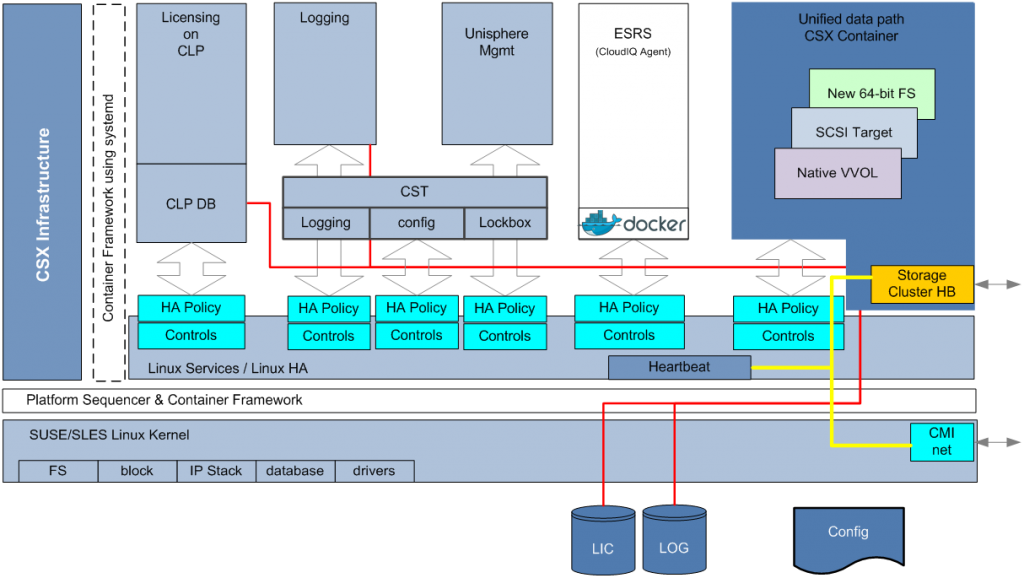Today, at EMC World, EMC announced their new mid-range unified storage platform, called Unity.
Some time last summer, I remember thinking that it was weird that we hadn’t seen a “Mega-Launch” event announcement from EMC. VNX2 seemed due for a refresh, but nothing happened. Now I know why — the EMC team was working on Unity instead.
I’ll be clear up-front: Unity is NOT “VNX3”. This is a completely-new architecture, and one that finally actually delivers on the “Unified” promise that VNX never quite achieved.
Let me take a moment to explain that. VNX is the child of two parents. Its block storage has its roots in the old CLARiiON array line, while its file storage has its roots in the Celerra product line.
VNX’s promise was the uniting of these two into a single platform, but it never quite made it.
Yes, VNX can be managed from a single interface (Unisphere), but when you look at the internals it was still NAS Data Movers direct-connected to a block storage array. Yes, it does both SAN and NAS, but inside, the two are still separate functions running separate code.
Unity is a dual-controller scale-up storage array. Both controllers perform both NAS and SAN functions. Unity comes in 2U building blocks, and is offered in two ways: All-Flash or Hybrid.
In the All-Flash models, the 2U controller enclosure includes space for 25 2.5″ SSD drives, and then can be expanded by adding 2U 25×2.5″ drive shelves. In the Hybrid models, the 2U controller enclosure can include space for either 25 2.5″ drives or 12 3.5″ drives, and then can be expanded by adding a mix of 2U 25×2.5″ and 12×3.5″ drive shelves.
I want to talk about that Flash/Hybrid split. When you order a Unity array, there are two questions that need to be answered at point of sale. The first is whether you’re ordering an All-Flash model, or a Hybrid model. The two are shown below, the All-Flash has a single-color logo on the bezel, while the Hybrid’s logo mixes two colors.
Once you’ve made that decision, there is no going back. Spinning disks cannot be added to an All-Flash Unity. A Hybrid Unity array cannot go above 50% Flash capacity.
There are four different All-Flash Unity models offered:
- 300F — Maximum of 150 drives with 1.5PB raw capacity
- 400F — Maximum of 250 drives with 2.5PB raw capacity
- 500F — Maximum of 500 drives with 3.5PB raw capacity
- 600F — Maximum of 1,000 drives with 5 PB raw capacity
Not too surprisingly, there are four different Hybrid Unity models offered with similar model numbers (simply remove the “F”). What is surprising to me is that — according the the Unity spec sheet — the maximum raw capacity is the same in the Hybrid models. (I’m hoping that’s a typo or oversight and that I’ll get to post a correction later…)
Another differentiator between Unity and VNX is that Unity can support filesystems up to 64TB in size, and offers the ability to dynamically grow and shrink filesystems.
Unity’s Operating Environment takes a brand-new more open approach. You can see a logical diagram below.
Yet another differentiator, the EMC remote Support gateway runs as a virtual machine in a Docker container within the Unity platform, providing that service to customers without requiring an additional device.
Continuing their recent trend, EMC also makes Unity available as a software-only option.
I’d said there were two questions you needed to answer at point of sale, but I only addressed the first. The second questions is whether or not the array will use data-at-rest encryption. This is a zero-cost option, but it’s a one-time only question. If you choose it, you can’t undo it, and if you don’t choose it, you can’t add it later.
Availability
Unity is order able now. The software-only version can be downloaded now as well.
A new model VCE Vblock based on Unity (the Model 350) will be available later this year.



Pingback: MiniCast, Season 1, Episode 3: EMC Unity with Mark Geel | GeekFluent
Pingback: EMC Announces Unity – Part 2 | penguinpunk.net